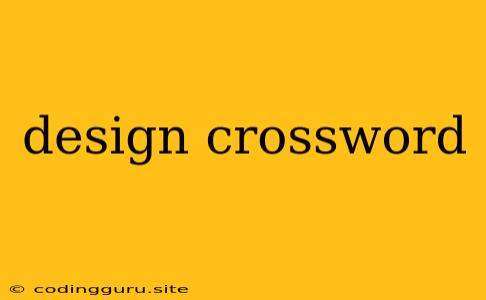Unravel the Fun: Design Your Own Crossword Puzzle
Crossword puzzles, those classic brain teasers that have entertained generations, offer more than just a fun way to spend your time. They stimulate your mind, challenge your vocabulary, and can even help you learn new things. But have you ever wondered what goes into creating one of these intricate word grids? Designing your own crossword puzzle is a rewarding experience that combines creativity, logic, and a dash of wordplay. Let's dive into the world of crossword design and discover how you can craft your own engaging puzzles.
Getting Started: Choose Your Theme
The first step in designing a crossword puzzle is to pick a theme. This will give your puzzle a focus and make it more engaging for your audience. Here are some ideas to spark your imagination:
- General Knowledge: Cover a broad range of subjects, from history and geography to science and pop culture.
- Specific Topics: Focus on a niche area, like a particular genre of music, a favorite hobby, or even a historical period.
- Puns and Wordplay: Embrace humor with puns, wordplay, and quirky clues.
- Seasonal or Holiday Themes: Create a crossword puzzle to celebrate special occasions like Halloween, Christmas, or the Fourth of July.
Planning Your Grid: The Layout
Once you have a theme, it's time to plan out the grid. Here are some considerations:
- Size: Start with a smaller grid (5x5 or 7x7) for your first puzzle. As you gain experience, you can tackle larger grids.
- Symmetry: Crossword grids are typically symmetrical, with a central square and equal numbers of squares on each side.
- Black Squares: Black squares are the key to creating the interlocking word paths. They should be placed strategically to create a visually pleasing and challenging puzzle.
Building Your Word List:
Now, it's time to gather your words. Here are some tips for crafting your list:
- Theme-Relevant: Select words that are closely related to your chosen theme.
- Variety: Use a mix of short and long words to create interesting intersections.
- Common Vocabulary: Focus on words that are relatively common to make the puzzle accessible to a wider audience.
- Word Length: The length of your words will determine the overall size of your grid. Try to have a balance of short and long words.
Crafting Engaging Clues:
The heart of any crossword puzzle lies in its clues. Here are some guidelines for crafting clues that are both challenging and fun:
- Concise and Specific: Clues should be brief and clear, avoiding unnecessary words.
- Direct and Indirect: Use a mix of direct and indirect clues to add variety. Direct clues simply define the word, while indirect clues offer hints or wordplay.
- Misdirection: Don't be afraid to use misdirection to make the puzzle more challenging. Use synonyms, double meanings, or unexpected wordplay.
Solving and Refining:
Once you have your word list and clues, create a draft of your puzzle. It's a good idea to test it yourself or with someone else to see how well it solves. Here are some tips for refining your puzzle:
- Check for Errors: Make sure all the words fit correctly in the grid and that there are no spelling or grammatical errors.
- Review Clues: Ensure that the clues are accurate, challenging, and fair. Are they too easy or too difficult?
- Seek Feedback: Ask for feedback from others to get an objective perspective on the difficulty and enjoyment of your puzzle.
Types of Crosswords:
There are several different types of crossword puzzles, each with its own unique style:
- American: These puzzles use primarily direct clues and tend to be more challenging.
- British: British-style crosswords often use cryptic clues that require more wordplay and deduction.
- Themed: Themed crosswords focus on a specific topic, like a movie, a historical event, or a holiday.
- Cryptic: Cryptic crosswords use wordplay and puns to create challenging clues.
Tools for Designing Your Crossword:
Several online and offline tools can assist you in designing your crossword:
- Online Crossword Generators: These websites offer pre-made grids and tools for adding words, clues, and formatting your puzzle.
- Software Programs: Specialized software programs like "Crossword Compiler" provide more advanced features, including editing, printing, and even publishing your puzzle.
- Pencil and Paper: The traditional method of designing a crossword using pencil and paper is a great way to get started and understand the basics.
Sharing Your Creation:
Once you're happy with your crossword puzzle, you can share it with the world! Here are some ways to showcase your work:
- Print and Distribute: Print your crossword puzzle and share it with friends, family, or colleagues.
- Online Platforms: Upload your puzzle to websites that host user-created crosswords.
- Social Media: Post your puzzle on social media platforms to challenge your followers.
Conclusion
Designing your own crossword puzzle is a fun and rewarding experience. By following these tips and experimenting with different techniques, you can create a puzzle that will challenge your mind and entertain your audience. So grab a pen, a piece of paper, and get ready to unleash your inner crossword designer!
